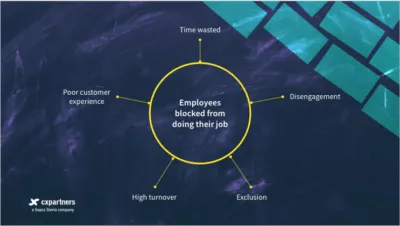22 Nov 2022
Why we all hate doing expenses – championing the employee experience
Although companies often define a customer experience, they rarely define an employee experience or who is responsible for it. Hannah Whiteley and Sophie Dennis explore the common indicators of poor employee experience, what this means for a business and how we can make improvements in order to deliver better customer experiences, faster.
-
Hannah Whiteley
Principal UX Consultant
Hannah Whiteley
-
Sophie Dennis
UK Health Security Agency
Sophie Dennis
In our third webinar for Customer Centricity Month 2022, Hannah Whiteley, Principal UX Consultant at cxpartners and Sophie Dennis, Director of Human-Centred Design & Customer Experience at the UK Health Security Agency, explored employee experience and the facilities dimension of our Customer Centricity Model.
What is employee experience?
For the last 18 months, I’ve been working in the employee experience space. In this webinar, I talked about what a bad employee experience looks like, why we should be looking at it and some ideas for how we can start to improve it.
Employee experience falls into the Facilities dimension of our Customer Centricity Model. Facilities include the tools you use for your job and the barriers that prevent you from doing your job effectively.
I’ve defined employee experience as:
The service you provide as an employer to your employees that enables them to be productive and happy.
There are many different touch points of employee experience. These could be systems – for example, expenses systems, holiday systems, and desk booking systems. They could be services – for example, HR, finance or IT. And finally, they could be people – such as line management or an IT service centre representative.
Although companies often define a customer experience, they rarely define an employee experience or who is responsible for it.
Work in a post-pandemic world
For 4 out of every 10 employees post-pandemic, work is now completely different. We’ve seen a shift in how people work and where they work. People are often hybrid or remote working.
The flip side of this is reduced social contact with your employers. This is the only way of working that Generation Z, who are coming into the workforce, will have ever known. So it’s something we need to adapt to and think about rather than resist.
What leads to a poor employee experience?
The first indicator of a bad employee experience that I’ve observed whilst working with different companies is disconnected employee experience teams. In large organisations, there are many teams who contribute to the employee experience, for example, HR or IT. But rarely is there one overarching team that takes responsibility for the overall employee experience. There might be confusion about which team provides which service to the end user. For example, expenses – does it sit with travel? Finance? HR? There might also be a disconnect in the way users are engaged with and how they are spoken to.
The second indicator is unsatisfactory internal tech. Often there’s a high level of investment in customer-facing tech but less investment in employee-facing tech. It can be difficult to use, slow, or inappropriate for the job. It could be non-existent because there’s no software in place for it to work. On the other side of this is security and data protection, which have quite a big stranglehold over what tech gets used and who gets to use it. The decision-makers are often quite far removed from the people who are actually going to be using the tech. Effective internal tech is more important than ever following the Covid-19 pandemic.
The third indicator of poor employee experience is when assumptions are made about user needs or experience. For example, assumptions about access to digital devices can lead to excluding some employees. Or assumptions about how much complexity employees can handle can end up making things unnecessarily hard for them.
The fourth indicator is a lack of measurement of employee experience. In order to understand whether anything you’ve done has made an impact, first you need to benchmark what’s going on right now. And once you’ve made a change, measure it again and compare.
The final indicator is ineffective or even a complete lack of feedback loops. Organisations often rely on a single measurement, for example, the Great Place to Work survey. But this doesn’t capture the ‘why’ of the employee experience, which can lead to assumptions being made. What really needs to happen is for employers to gather the feedback and then go back to their employees and let them know what they’ve done and what they’re in the process of doing based on the feedback. By bringing employees along on the journey and making sure they’re involved, you’re ensuring you’ve got it right.
The impact of poor employee experience
Time
The biggest impact of a bad employee experience is employees being blocked from doing their job effectively. The frustration starts to mount because they don’t have the right tools or because there are barriers in place. This can lead to time being wasted.
We recently studied the time it takes for employees to download a payslip. On average, it took people around seven minutes from beginning to end. We then extrapolated that it was roughly 907,200 hours per year that people in this company were spending downloading payslips. It’s a very small task that shouldn’t take this long. Managers are much more adversely affected because they have more of these admin tasks to complete.
Disengagement
If the systems in place are making it too hard for employees to do their jobs, it creates disengagement. This leads to reduced productivity, reduced energy levels and reduced morale. This can spread like wildfire across the team.
Exclusion
The tools and processes that an organisation has in place may not be accessible to all. Employees may have varying levels of digital literacy, access to different devices, differing levels of WiFi connectivity, or they may have accessibility issues.
If you have certain systems designed to be used in an office, you’re going to be excluding people who work remotely or in the field if they’re not accessible to all.
High turnover
If employees don’t feel trusted, don’t have the right tools or are not listened to, they will leave. The knock-on effect of this can be poor reviews on sites like Glassdoor or LinkedIn. CIPD estimates the average cost of filling a vacancy, including labour costs, is £6,125. For a manager role, these figures rise to £19,000.
Poor customer experience
Ultimately, poor employee experience leads to poor customer experience because employees are not empowered to do what they need to do to impact the customer experience.
For example, using a ResearchOps team to plan and recruit user research hugely streamlines the process, reduces cognitive effort on the UX team, and ultimately gives you more insights on the customer experience.

How can we improve the employee experience?
Put ‘customers’ at the heart of everything
Just like external customer experience, employee experience should be at the heart of everything you do. Listen to your employees, and understand their needs and motivators.
Define goals around what you want the experience to be. This should help highlight where problems exist.
Internal EX team with defined goals
Consider creating an internal employee experience team with overarching responsibility for the user experience across the whole business. Their objectives would be to break down the barriers between teams that deliver the service to customers, define the goals for the service, what you want the employee experience to be and how it works, and build that deep empathy and understanding of what your employees need. Ultimately their goal would be to remove the barriers to people doing their job well.
Invest in internal tech
Considering the number of hours that were wasted downloading a payslip in the study we conducted, which was only one of about twenty tasks employees needed to do, the amount of money wasted is staggering.
Before investing in a piece of technology, organisations should consider the user needs. Working with security people and data management people helps to ensure you’re getting the best use of technology. Rather than making blanket decisions across the whole business, the decision-makers need to really understand what employees need from that piece of technology.
The tech you use does reflect who you are as a company.
Entrust and empower
Trust your employees, work with security to unblock some of the barriers, and put more trust in the employees to define what they want to use and how they want to use it.
Measure and create feedback loops
Before making a change, benchmark the experience. This allows you to keep measuring whether your actions have had an impact. People can resist change unless they see clear value, so having those metrics helps get users’ buy-in.
Why do this?
If employees have the appropriate tech, they’re unblocked from doing their job because the processes are smooth and easy to use. If they know how to access information and services and it feels easy, you’re taking away that stress and cognitive load. This allows employees to focus on delivering a great product, a great service, and, most importantly, on delivering a great customer experience for your customers.
EX in action – UK Health Security Agency
Sophie Dennis is a Design Director who has spent the last two years scaling human-centred design at NHS Test & Trace from 0 to 120 people in just 18 months.
Why ‘customer centricity’ is relevant to the public sector
Sophie defined customer-centricity in the public sector as ‘prioritising creating value for the people they serve over other organisational considerations such as reputation, short-term profit, cost reduction, or delivery deadlines’. Improving the user experience of internal tools and systems used by the frontline customer-facing staff greatly impacts all other dimensions of the customer-centricity model.
To have the most impact on the employee experience, firstly, focus on improving the user experience of internal tools and systems used by frontline customer-facing staff. Secondly, focus on reducing friction for your own design and research team through practices like design and research ops, and operational tooling.
Improving internal tools and systems
In the NHS, the user experience of the software systems used by clinicians and support staff is just as important to the patient experience as the patient-facing digital tools. The ‘easy’ bit is putting the consistent front-end veneer on the customer-facing tools. However, eventually, the places where backend systems don’t join up prevent the NHS from offering patients the experience they need.
Not only does the staff experience of the systems they use every day directly impact patient experience, but it also affects patients in other ways, namely staff productivity and clinical quality and safety.
The issue with the NHS is not just that there aren’t enough staff, it’s that they don’t have the infrastructure needed to do their jobs efficiently and effectively. There is chronic underinvestment in IT and digital, from basic equipment to usability of bespoke and custom software. In some departments, small improvements to IT would have a massive leveraging effect.
The impact of usability on clinical quality and safety can be a really serious issue. The quality of clinical decision-making depends on doctors and clinicians being able to access and absorb large quantities of information quickly. They need to be able to see key patient information all in one place. However, patient records are held in multiple locations meaning they have to log into multiple systems separately to access a patient’s information. Sadly when doctors don’t get that information because all the systems they’re using aren’t usable, this has led to tragic incidents where patient safety was seriously compromised through poor usability.
Reducing friction for your own design and research team
One of the first things Sophie did in setting up the Test & Trace Human Centred Design team was to hire a Research Ops Lead and a Talent Manager to provide dedicated support. Working within a large bureaucracy, it helped to have people dedicated to cutting through that and joining it all up. This greatly impacted how quickly and efficiently people could work.
By giving your UX and design teams the tools they need, you can enable them to do their jobs. However, your greatest gift as a design leader is giving your team time, space and permission to do their work. Ultimately, giving people the right tools to do their job and permission to do it signals that you trust them.
Customer Centricity Month 2022
To find out how you can drive your customer centricity strategy forward, check out all four of the webinars that we held during Customer Centricity Month. Available to watch on demand here:
Learn more about Why we all hate doing expenses – championing the employee experience

Reach out to Hannah Whiteley
Principal UX Consultant




